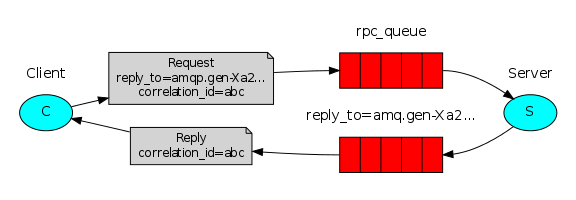一 RabbitMQ简介
RabbitMQ是一个在AMQP基础上完整的,可复用的企业消息系统。他遵循Mozilla Public License开源协议。
MQ全称为Message Queue, 消息队列(MQ)是一种应用程序对应用程序的通信方法。应用程序通过读写出入队列的消息(针对应用程序的数据)来通信,而无需专用连接来链接它们。消 息传递指的是程序之间通过在消息中发送数据进行通信,而不是通过直接调用彼此来通信,直接调用通常是用于诸如远程过程调用的技术。排队指的是应用程序通过 队列来通信。队列的使用除去了接收和发送应用程序同时执行的要求。
二 安装RabbitMQ
Linux系统
yum install rabbitmq-server
启动服务
service rabbitmq-server start 默认端口5672
Python环境安装pika模块
pip install pika
查看当前有多少个队列并且队列中有多少消息
rabbitmqctl list_queues
三 一个简易的生产者消费者模型
生产者:
import pika connection = pika.BlockingConnection( pika.ConnectionParameters('192.168.0.108') ) channel = connection.channel() # 声明一个管道 # 声明queue channel.queue_declare(queue='hello queue2', durable=True) # durable 持久化队列 channel.basic_publish( exchange='', routing_key='hello queue2', # queue名字 body='Hello World!', # 消息内容 properties=pika.BasicProperties( delivery_mode=2 # 使队列中的消息持久化 ) ) print("[x] Sent 'Hello World!'") connection.close()
消费者:
import pika connection = pika.BlockingConnection(pika.ConnectionParameters('192.168.0.108')) channel = connection.channel() channel.queue_declare(queue='hello queue') def callback(ch, method, properties, body): print('ch', ch) # 管道的内存对象地址 print('me', method) print('pro', properties) print('body', body) # 消息内容 print("[x] Received %r" % body) ch.basic_ack(delivery_tag=method.delivery_tag) # 向生产者发送确认消息 channel.basic_qos(prefetch_count=1) # 处理完当前这条信息再发送下一条消息,公平消息机制,这样就不会因为某些处理速度慢的机器一直收到消息而处理不完 channel.basic_consume( # 消费信息 callback, # 如果收到消息,就调用CALLBACK函数来处理消息 queue='hello queue', no_ack=True) print('[*] Waiting for message. to exit press CTRL+C') # 开始收消息 channel.start_consuming()
1、acknowledgment 消息不丢失
no-ack = False,如果消费者遇到情况(its channel is closed, connection is closed, or TCP connection is lost)挂掉了,那么,RabbitMQ会重新将该任务添加到队列中。
RabbitMQ是默认开启自动应答的,这样当rabbitMQ将消息发给消费者,就会从内存中将消息删除,这样会带来一个问题,如果消费者未处理完消息而宕机,那么消息就会丢失。所以,我们将自动应答关闭,当rabbitMQ收到消费者处理完消息的回应后才会从内存中删除消息。


import pika connection = pika.BlockingConnection(pika.ConnectionParameters( host='10.211.55.4')) channel = connection.channel() channel.queue_declare(queue='hello') def callback(ch, method, properties, body): print(" [x] Received %r" % body) import time time.sleep(10) print 'ok' ch.basic_ack(delivery_tag = method.delivery_tag) channel.basic_consume(callback, queue='hello', no_ack=False) print(' [*] Waiting for messages. To exit press CTRL+C') channel.start_consuming()
2、durable 消息不丢失
rabbitMQ默认将消息存储在内存中,若rabbitMQ宕机,那么所有数据就会丢失,所以在声明队列的时候可以声明将数据持久化,但是如果已经声明了一个未持久化的队列,那么不能修改,只能将这个队列删除或重新声明一个持久化数据。


#!/usr/bin/env python import pika connection = pika.BlockingConnection(pika.ConnectionParameters(host='10.211.55.4')) channel = connection.channel() # make message persistent channel.queue_declare(queue='hello', durable=True) channel.basic_publish(exchange='', routing_key='hello', body='Hello World!', properties=pika.BasicProperties( delivery_mode=2, # make message persistent )) print(" [x] Sent 'Hello World!'") connection.close()


#!/usr/bin/env python # -*- coding:utf-8 -*- import pika connection = pika.BlockingConnection(pika.ConnectionParameters(host='10.211.55.4')) channel = connection.channel() # make message persistent channel.queue_declare(queue='hello', durable=True) def callback(ch, method, properties, body): print(" [x] Received %r" % body) import time time.sleep(10) print 'ok' ch.basic_ack(delivery_tag = method.delivery_tag) channel.basic_consume(callback, queue='hello', no_ack=False) print(' [*] Waiting for messages. To exit press CTRL+C') channel.start_consuming()
3、消息获取顺序
默认消息队列里的数据是按照顺序被消费者拿走,例如:消费者1 去队列中获取 奇数 序列的任务,消费者2去队列中获取 偶数 序列的任务。
channel.basic_qos(prefetch_count=1) 表示谁来谁取,不再按照奇偶数排列, 处理完当前这条信息再发送下一条消息,公平消息机制,这样就不会因为某些处理速度慢的机器一直收到消息而处理不完


import pika connection = pika.BlockingConnection(pika.ConnectionParameters('192.168.0.108')) channel = connection.channel() channel.queue_declare(queue='hello queue') def callback(ch, method, properties, body): print('ch', ch) # 管道的内存对象地址 print('me', method) print('pro', properties) print('body', body) # 消息内容 print("[x] Received %r" % body) ch.basic_ack(delivery_tag=method.delivery_tag) # 向生产者发送确认消息 channel.basic_qos(prefetch_count=1) # 处理完当前这条信息再发送下一条消息,公平消息机制,这样就不会因为某些处理速度慢的机器一直收到消息而处理不完 channel.basic_consume( # 消费信息 callback, # 如果收到消息,就调用CALLBACK函数来处理消息 queue='hello queue', no_ack=True) print('[*] Waiting for message. to exit press CTRL+C') # 开始收消息 channel.start_consuming()
四 消息发布与订阅
之前的例子基本都是1对1的消息发送和接收,即消息只能发送到指定的queue里,但有些时候你想让你的消息被所有的Queue收到,类似广播的效果,这时候就要用到exchange了
Exchange在定义的时候是有类型的,以决定到底哪些Queue符合条件。
fanout:所有bind到此exchange的queue都可以接收消息
direct:通过routingKey和exchage决定的那个唯一的queue可接收消息
topic:所有符合routingKey(此时可以说一个表达式)的routingKey所bind的queue可以接收消息
表达式符号说明:#代表一个或多个字符, *代表任何字符
例: #.a会匹配a.a, aa.a, aaa.a等
*.a会匹配a.a, b.a, c.a 等
注意:使用RoutingKey为#, Exchange Type为topic的时候相当于fanout
headers: 通过headers来决定把消息发给哪些queue
1 fanout
RabbitMQ实现发布和订阅时,会为每一个订阅者创建一个队列,而发布者发布消息时,会将消息放置在所有相关队列中。


import pika import sys connection = pika.BlockingConnection(pika.ConnectionParameters( host='192.168.0.108')) channel = connection.channel() channel.exchange_declare(exchange='logs', exchange_type='fanout') message = ''.join(sys.argv[1:]) or "info: Hello World!" channel.basic_publish(exchange='logs', routing_key='', body=message) print("[x] Sent %r" % message)


import pika connection = pika.BlockingConnection(pika.ConnectionParameters(host='192.168.0.108')) chanel = connection.channel() chanel.exchange_declare(exchange='logs', exchange_type='fanout') # 不指定queue名字, rabbit会随机分配一个名字,exclusive=True会在使用此queue的消费者断开后,自动将queue删除 result = chanel.queue_declare(exclusive=True) # 拿到随机的queue名字 queue_name = result.method.queue print(queue_name) chanel.queue_bind(exchange='logs', queue=queue_name) def callback(ch, method, properties, body): print(body) chanel.basic_consume( callback, queue=queue_name, no_ack=True ) print('[*] Waiting for message. to exit press CTRL+C') chanel.start_consuming()
2 direct模式
之前事例,发送消息时明确指定某个队列并向其中发送消息,RabbitMQ还支持根据关键字发送,即:队列绑定关键字,发送者将数据根据关键字发送到消息exchange,exchange根据 关键字 判定应该将数据发送至指定队列。


import pika import sys connection = pika.BlockingConnection(pika.ConnectionParameters(host='192.168.0.108')) chanel = connection.channel() chanel.exchange_declare(exchange='direct_logs', exchange_type='direct') severity = sys.argv[1] if len(sys.argv) > 1 else 'info' message = ' '.join(sys.argv[2:]) or 'Hello World' chanel.basic_publish( exchange='direct_logs', routing_key=severity, body=message ) print("[x] Sent %r:%r" % (severity, message)) connection.close()


import pika import sys connection = pika.BlockingConnection(pika.ConnectionParameters(host='192.168.0.108')) chanel = connection.channel() chanel.exchange_declare(exchange='logs', exchange_type='fanout') result = chanel.queue_declare(exclusive=True) queue_name = result.method.queue severities = sys.argv[1:] if not severities: sys.stderr.write("Usage:%s [info] [warning] [error]\n" % sys.argv[0]) sys.exit(1) for severity in severities: chanel.queue_bind(exchange='direct_logs', queue=queue_name, routing_key=severity) def callback(ch, method, properties, body): print("[x] %r:%r" % (method.routing_key, body)) chanel.basic_consume(callback, queue=queue_name, no_ack=True) print('[*] Waiting for message. to exit press CTRL+C') chanel.start_consuming()
3 topic模式
在topic类型下,可以让队列绑定几个模糊的关键字,之后发送者将数据发送到exchange,exchange将传入”路由值“和 ”关键字“进行匹配,匹配成功,则将数据发送到指定队列。
- # 表示可以匹配 0 个 或 多个 单词
- * 表示只能匹配 一个 单词


import pika import sys connection = pika.BlockingConnection(pika.ConnectionParameters(host='192.168.0.108')) channel = connection.channel() channel.exchange_declare(exchange='topic_logs', exchange_type='topic') routing_key = sys.argv[1] if len(sys.argv) > 1 else 'anonymous.info' message = ' '.join(sys.argv[2:]) or 'Hello World' channel.basic_publish(exchange='topic_logs', routing_key=routing_key, body=message) print("[x] sent %r:%r " % (routing_key, message)) connection.close()


import pika import sys connection = pika.BlockingConnection(pika.ConnectionParameters(host='192.168.0.108')) chanel = connection.channel() chanel.exchange_declare(exchange='topic_logs', exchange_type='topic') result = chanel.queue_declare(exclusive=True) queue_name = result.method.queue binding_keys = sys.argv[1:] if not binding_keys: sys.stderr.write("Usage:%s [binding_keys]\n" % sys.argv[0]) sys.exit(1) for severity in binding_keys: chanel.queue_bind(exchange='topic_logs', queue=queue_name, routing_key=severity) def callback(ch, method, properties, body): print("[x] %r:%r" % (method.routing_key, body)) chanel.basic_consume(callback, queue=queue_name, no_ack=True) print('[*] Waiting for message. to exit press CTRL+C') chanel.start_consuming()
五 Remote procedure call (RPC)
To illustrate how an RPC service could be used we're going to create a simple client class. It's going to expose a method named call which sends an RPC request and blocks until the answer is received:
fibonacci_rpc = FibonacciRpcClient()
result = fibonacci_rpc.call(4)
print("fib(4) is %r" % result)RPC server:
import pika import time connection = pika.BlockingConnection(pika.ConnectionParameters(host="192.168.0.108")) channel = connection.channel() channel.queue_declare(queue='rpc_queue') def fib(n): if n == 0: return 0 elif n == 1: return 1 else: return fib(n - 1) + fib(n - 2) def on_request(ch, method, props, body): n = int(body) print("[.]fib(%s)" % n) response = fib(n) ch.basic_publish(exchange='', routing_key=props.reply_to, properties=pika.BasicProperties(correlation_id=props.correlation_id), body=str(response)) ch.basic_ack(delivery_tag=method.delivery_tag) channel.basic_qos(prefetch_count=1) channel.basic_consume(on_request, queue='rpc_queue')
RPC client
import pika import uuid class FibonacciRpcClient(object): def __init__(self): self.connection = pika.BlockingConnection(pika.ConnectionParameters(host='192.168.0.108')) self.channel = self.connection.channel() result = self.channel.queue_declare(exclusive=True) self.callback_queue = result.method.queue self.channel.basic_consume(self.on_response, no_ack=True, queue=self.callback_queue) self.response = None def on_response(self, ch, method, props, body): if self.corr_id == props.correlation_id: self.response = body def call(self, n): self.corr_id = str(uuid.uuid4()) self.channel.basic_publish(exchange='', routing_key='rpc_queue', properties=pika.BasicProperties( reply_to=self.callback_queue, correlation_id=self.corr_id ), body=str(n) ) while self.response is None: self.connection.process_data_events() return int(self.response) fibonacci_rpc = FibonacciRpcClient() print("[X]Requesting fib") response = fibonacci_rpc.call(30) print("[.]Got %r" % response) print("[X] Awaiting RPC request") channel.start_consuming()



